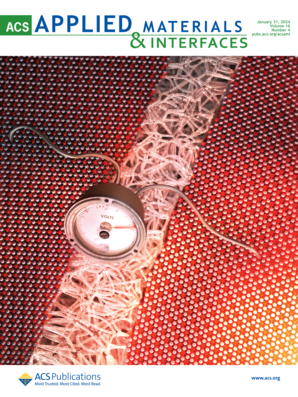在异质结光催化中裁剪多尺度界面去除NOx。
IF 8.2
2区 材料科学
Q1 MATERIALS SCIENCE, MULTIDISCIPLINARY
引用次数: 0
摘要
氮氧化物(NOx)严重威胁人类健康和生态系统。光催化技术为消除低浓度但剧毒的NO提供了很有前途的解决方案。然而,它在催化剂稳定性、中间产物和最终产物的控制、反应选择性和界面机理的揭示等方面面临着挑战。克服这些障碍的关键是有效的载体分离,这对于光催化剂中不同的氧化还原反应至关重要。此外,光照射下载流子效率(形成、转移、分离和进一步的动力学)和催化剂光腐蚀显著影响金属氧化物基体系的光催化性能和长期稳定性。异质结以其优越的载流子分离效率,能有效调节NO转化过程中的反应途径。此外,异质结工程已被证明可以通过优化界面电荷转移和降低脆弱活性位点上的电荷积累水平来减轻光腐蚀。尽管关于光催化异质结的评论越来越多,但在系统地统一各种异质结的分类、合成和应用,专门用于去除NO,同时明确地将多尺度界面工程(如原子级缺陷、纳米级带对准、分子吸附)与反应途径和选择性的精确控制联系起来的工作中,存在着一个关键的空白。为了解决这一差距,本文建立了一个创新的、统一的框架,将异质结原理、分类和构建方法与它们在去除NO中的操作性能结合起来,重点介绍了它们的最新进展。独特的是,它直接映射设计策略来克服现实世界的瓶颈,如副产物抑制,相对湿度抵抗和选择性增强。它解释了最先进的应用,突出了界面工程如何协同提高载体效率和产品控制。通过强调通过活性氧生成提高载体效率和控制中间/最终产物形成的重要性,本文综述为指导未来研究获得更高的NO转化率和反应选择性提供了有价值的见解。此外,它还为开发更有效、更环保的环境清理技术奠定了基础。本文章由计算机程序翻译,如有差异,请以英文原文为准。
Tailoring Multiscale Interfaces in Heterojunction Photocatalysis for NOx Removal.
Nitrogen oxides (NOx) severely threaten human health and ecosystems. Photocatalytic technology offers a promising solution for eliminating low-concentration yet highly toxic NO. However, it faces challenges in catalyst stability, control of intermediate and final products, reaction selectivity, and disclosure of interfacial mechanisms. The key to surmounting these hurdles is effective carrier separation, vital for distinct redox reactions in photocatalysts. Additionally, the charge carrier efficiency (formation, transfer, separation, and further dynamics) and catalyst photocorrosion upon light irradiation significantly influence the photocatalytic performance and long-term stability of metal oxide-based systems. Heterojunctions, with their superior charge carrier separation efficiency, can effectively regulate the reaction pathways during NO conversion. Moreover, heterojunction engineering has been proven to mitigate photocorrosion by optimizing interfacial charge transfer and reducing the level of charge accumulation on vulnerable active sites. Despite the proliferation of reviews on photocatalytic heterojunctions, a critical gap exists in works that systematically unify the classification, synthesis, and application of diverse heterojunctions specifically for NO removal, while explicitly linking multiscale interfacial engineering, e.g., atomic-level defects, nanoscale band alignment, molecular adsorption to the precise control of reaction pathways and selectivity. Addressing this gap, this review establishes an innovative, unified framework that integrates heterojunction principles, classifications, and construction methods with their operational performance in NO removal, with an emphasis on their latest advancements. Uniquely, it maps design strategies directly to overcome real-world bottlenecks, such as byproduct suppression, relative humidity resistance, and selectivity enhancement. It interprets the state-of-the-art applications, highlighting how interfacial engineering synergistically enhances carrier efficiency and product control. By emphasizing the significance of improving carrier efficiency and controlling intermediate/final product formation by reactive oxygen species generation, this review provides valuable insights to guide future research toward securing higher NO conversions and reaction selectivity. Additionally, it lays the groundwork for the development of more effective and eco-friendly environmental cleanup technologies.
求助全文
通过发布文献求助,成功后即可免费获取论文全文。
去求助
来源期刊

ACS Applied Materials & Interfaces
工程技术-材料科学:综合
CiteScore
16.00
自引率
6.30%
发文量
4978
审稿时长
1.8 months
期刊介绍:
ACS Applied Materials & Interfaces is a leading interdisciplinary journal that brings together chemists, engineers, physicists, and biologists to explore the development and utilization of newly-discovered materials and interfacial processes for specific applications. Our journal has experienced remarkable growth since its establishment in 2009, both in terms of the number of articles published and the impact of the research showcased. We are proud to foster a truly global community, with the majority of published articles originating from outside the United States, reflecting the rapid growth of applied research worldwide.
 求助内容:
求助内容: 应助结果提醒方式:
应助结果提醒方式:


